The 25th Japan Media Arts Festival Award-winning Works Exhibition was held from Friday, September 16 to Monday, September 26, 2022. During this period, related events including talk sessions and workshops took place. The talk session on the Grand Prize-winning entry in the Manga Division, Golden Raspberry, was webcast on the festival’s official website. The session was attended by MOCHIDA Aki, the manga artist who was awarded the Grand Prize for Golden Raspberry; MATSUNAGA Tomoko, an editor at ShuCream Inc. and the supervising editor of the present series of articles; and OZAWA Yuki, a manga artist who was one of the jurors for the Manga Division, and was hosted by TOYODA Yumetaro, a manga editor and a selection member for the Manga Division. This article reports on the details of their conversation.
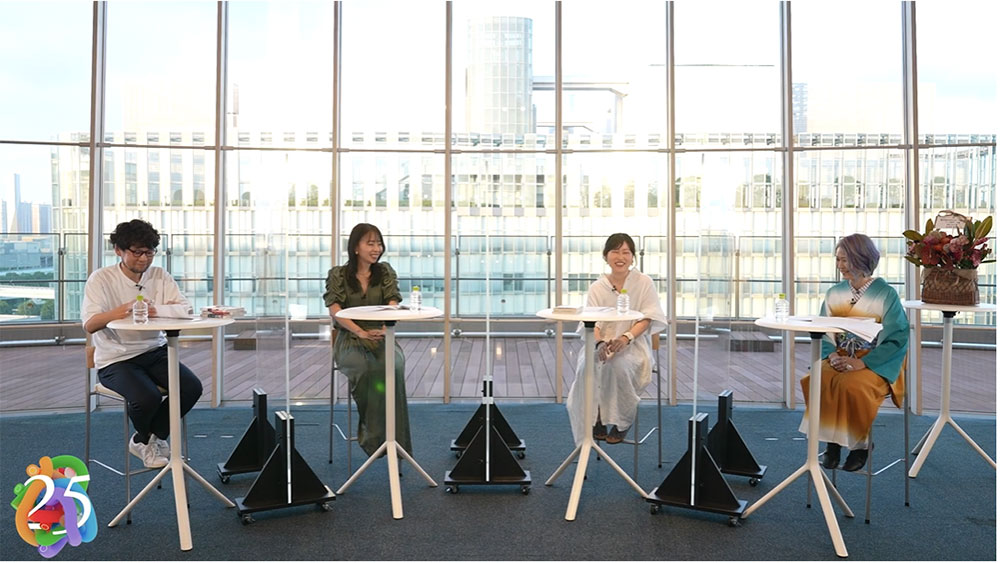
Golden Raspberry by MOCHIDA Aki has been serialized in the josei manga (women’s comic) magazine Feel Young (Shodensha Publishing) since 2020. The story’s main character is a young man named KITAKATA Keisuke, a manager at a talent agency who has changed jobs 24 times. He has scouted YOSHIKAWA Rui, a young woman working for a company in Tokyo’s shitamachi old town district. Keisuke is a highly educated and able man but he cannot stay in one job for very long. Rui is popular with men but she is unable to stay in a relationship for very long. This story depicts two people, both somewhat out of step with society, as they struggle to achieve success. The discussion covered a variety of topics ranging from the appeal of this work and the story behind its production to the future of josei manga.
Asked about her initial reaction to the news of her winning the award, MOCHIDA expressed her delight and her gratitude to MATSUNAGA. “I was simply amazed. Of course, I was honored and very happy. But at the same time, I felt that, as my editor, MATSUNAGA Tomoko also deserved the award. She gave me an opportunity to write for Feel Young even though my works up to then had been aimed at girls a little younger than the magazine’s readers. She encouraged me and gave advice from the very beginning when I had no idea what I could do in that field, which was new to me. Just as Keisuke tried to seduce Rui, she tried enthusiastically to seduce me (laughs). And I am very happy because of that too.”
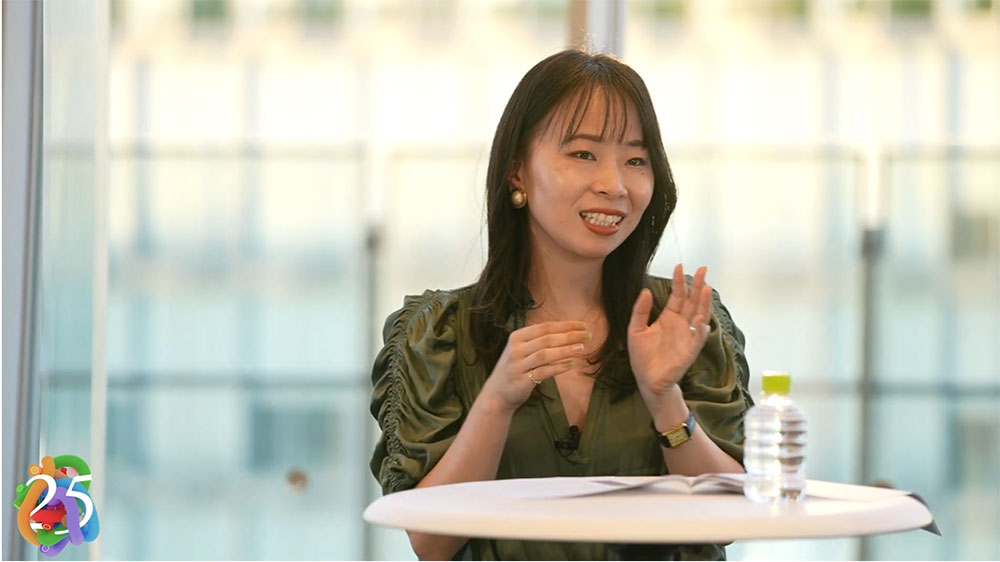
TOYODA Yumetaro asked OZAWA Yuki, who served as a juror for the Manga Division, about how the selection was made and what the jurors discussed during the process. OZAWA answered, “This work was of indisputable quality and it was very highly evaluated not only by me but also by the other jurors. While we were engaged in careful deliberations to finalize the Grand Prize winner, I mentioned the freshness of the angle from which this manga was created and I said that it would be hugely significant if the genre of josei manga could be thrust center stage by this remarkable work. The work was so highly acclaimed by the committee’s members that we finally selected it as the unanimous winner.” In response to this, TOYODA, who was a selection committee member himself, added his own recollections of the selection process and confirmed that the final result was satisfactory to everyone.

From this point, the discussion moved on to an exploration of the appeal of the work from a number of different angles. Regarding the artwork, TOYODA quoted a passage, “The readers are struck by the philosophical yet sincere eyes of the heroine YOSHIKAWA Rui,” from the Reason for the Award written by OZAWA. He specifically referred to power of Rui’s eyes, which are expressed with delicate and sharp pen strokes.
MOCHIDA said, “The people I work with, including my assistants, are mostly younger than me. They are very young and they probably don’t have much experience yet, but I occasionally meet a girl whose gaze somehow scares me. For example, the girl may look quiet while she is drawing a manga but she pours out her hidden passion onto the paper. I feel excited when I see such girls and I even secretly fall in love with them (laughs). Regardless of age or gender, an intent look can be frightening, and at the same time I feel impressed and overwhelmed by the allure of such eyes. When I draw a character like Rui, I recall what I felt when I met such people in real life and I try to create expressions that attract readers.” OZAWA followed this with the comment, “My own way of drawing characters is somewhat descriptive. In other words, I try to make the gestures easy for the readers to follow. In contrast, MOCHIDA’s style is characterized by captivating pictures. Her punchy frames are superb. As TOYODA mentioned earlier, the strength of Rui’s eyes naturally conveys the strength of her character as a person, which draws the readers into the story and captivates them. This work is a stunning display of the power of pictures.”
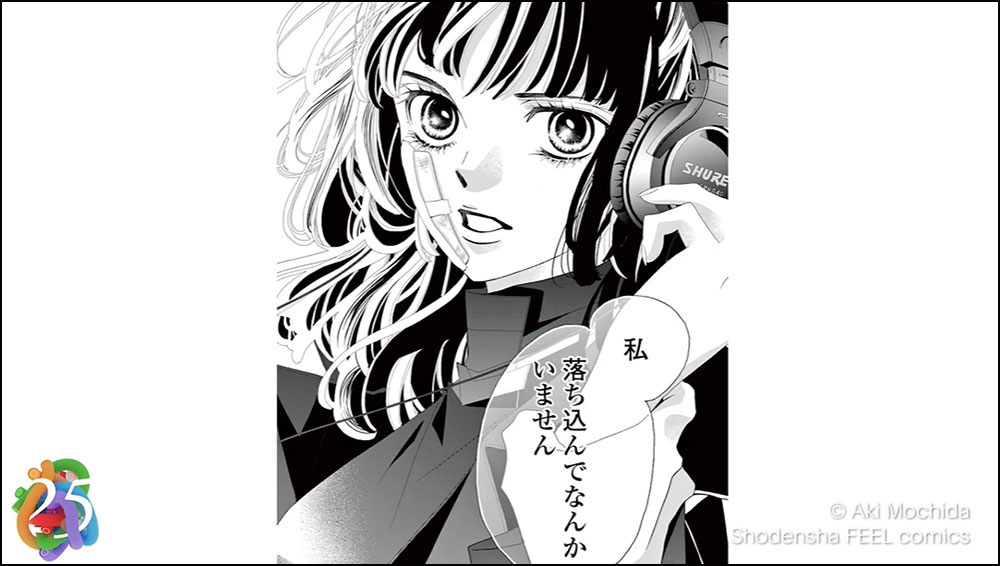
Next, the discussion shifted to the setting of the story, which is another of Golden Raspberry’s attractions. Keisuke is the protagonist and the narrator, and the story unfolds through his monologues. The heroine Rui is depicted from Keisuke’s perspective throughout and her own feelings and thoughts are not revealed. As a result, TOYODA explained, the readers perceive Rui’s powerful eyes discussed in the previous section and her bold actions and words from Keisuke’s viewpoint, which is what allows them to relate to the protagonist and to fall for Rui. TOYODA then asked the question, “Wasn’t it a courageous decision to place a male narrator in a josei manga?” And MATSUNAGA answered by recalling the situation. “Before even deciding on the entertainment industry as the setting of the story, MOCHIDA asked me whether we could have a male protagonist. It was striking to be asked such a question. I had never imagined doing that and I wasn’t sure if we had any chance of bringing it off successfully. Still, it was a little out of the ordinary to tell a story from a male perspective in a josei manga and I thought it would be interesting. So, I decided to go ahead with the project and make a wager on the potential of her idea.”
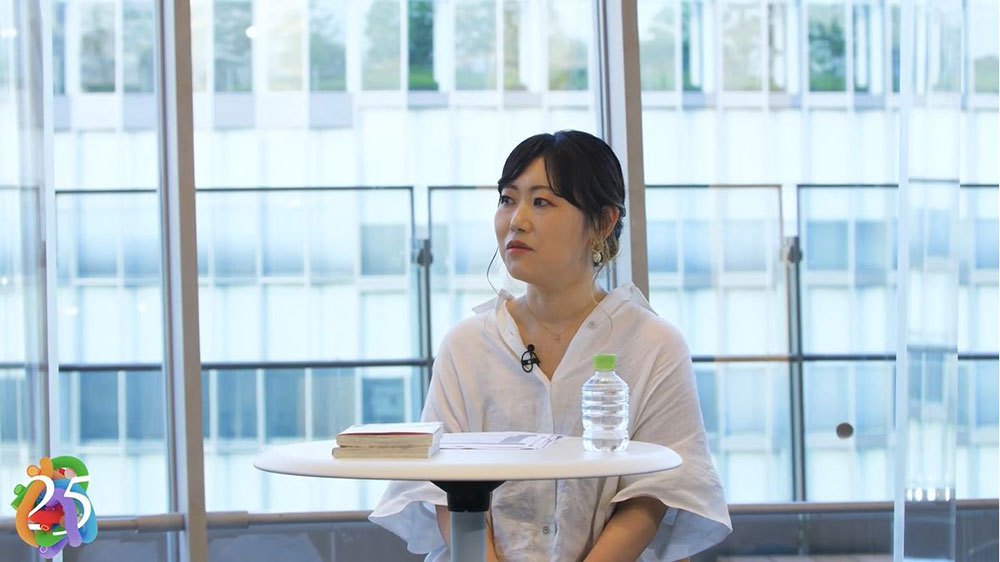
MOCHIDA was asked whether she was already considering adopting the perspective of Keisuke when she got the idea for the story and she replied, “Yes, I think I was. I wanted Rui to possess a mysterious appeal that is difficult to understand, so that before they know it, the readers find themselves eager to know what she is thinking. I decided to make a man the protagonist so that the readers would feel like they were pursuing Rui together with him.”
On the subject of the reversal of gender roles portrayed in conventional josei manga, TOYODA quoted a second passage from the Reason for the Award written by OZAWA: “… demonstrate a new form of romance that goes beyond conventional gender roles.” He asked OZAWA how this work can be viewed and what can be discerned by reinterpreting it from the standpoint of gender. OZAWA said, “Rui is depicted as a new type of woman who has moved way beyond the conventional role of women or the position that women are expected to assume in romantic relationships. She exists not so much as a woman but as a human being with a distinct character. That is why women will feel exhilarated when reading this manga, and that is why I used the expression, ‘beyond conventional gender roles.’ In addition, Rui and Keisuke, as well as having romantic feelings for each other, are also partners, as an actress and her manager, which again is very unconventional. I hope they will continue to build on this buddy relationship.”
MOCHIDA explained, “I think that Keisuke is attracted to Rui mainly because he is so engrossed in his work that he is oblivious to his own position. He completely forgets that he is a novice actress’s manager who has to teach her and also about the fact that he is a man, and he strives to work with Rui as a good partner, telling her how amazing she is and how much he respects her. I hope their friendly rivalry and the way they stare at each other are perceived by the readers as sexy or romantic.” This remark shows once again that Golden Raspberry is not a mere romance manga but rather a story depicting the existence of human beings as individuals.
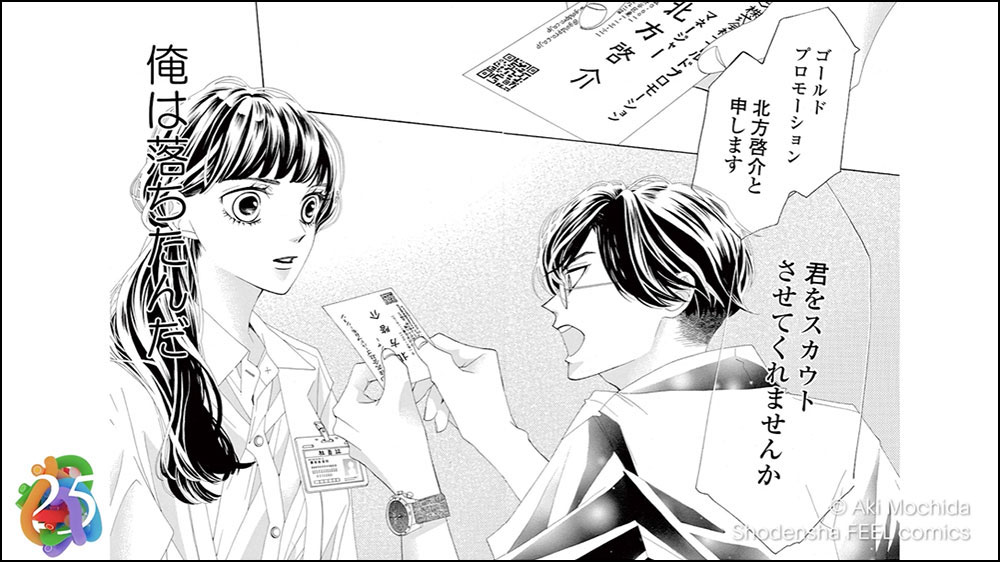
MATSUNAGA added, “The protagonists of most josei manga stories are women or girls. The readers relate to or empathize with these female characters. Even when there is a cool male character, his feelings are not revealed, and the protagonist is anxious because she doesn’t know what he is thinking. However, in this work, the protagonist is a man, the story is told from his perspective, and the heroine doesn’t engage in any monologues. Furthermore, while the story was unfolding, the comments we received from readers on social media were overwhelmingly along the lines of “Rui is cool and handsome” and “I want to root for Keisuke and encourage him to go for it!” All in all, this work shattered my deeply entrenched stereotypical perceptions of gender in josei manga.”
MOCHIDA made her debut in Shueisha’s Ribon magazine in 2000 when she was a first-year high school student and she has been a manga artist for 23 years. During her career, there was a time when she wasn’t sure about the direction of her manga. MOCHIDA said, “ Ribon is a magazine with a pure and unwavering message about romance that mainly targets elementary and junior high school girls. I had been shy since my school days and I didn’t like talking with other girls about love interests. On top of that, I had a complex about not being good at writing love stories.” A turning point came in her mid-20s, when she and her mother were taking care of her sick father.
MOCHIDA continued, recounting the details of an episode, “In his later years, due to the side-effects of his medication, my father couldn’t recognize my mother, let alone himself. One day, during a lull, he suddenly said to my mother, ‘You are so beautiful. Will you marry me?’, which made her very happy. That really struck me. If he had said something like, ‘You are so kind,’ or ‘Thank you for being nice to me,’ she wouldn’t have felt nearly as happy and I wouldn’t have been surprised so much. I realized then that I’d had no idea how powerful words such as ‘You are beautiful’ or ‘I love you’ could be for a woman when spoken by someone she loved. I was writing girls’ manga without being aware of such feelings at all. So, I decided to stop being shy and just go for it without being afraid to fail. I tried to explicitly depict how happy it is to be loved and the lover’s feelings toward their beloved. From that point, I remember, my style changed.”
Towards the end of the talk session, the participants reaffirmed that this work opened up new horizons for josei manga, and each speaker stated their views on how they expected the forms of josei manga to evolve in future.
OZAWA commented, “The majority of current josei manga consist of human dramas, stories centered on conversations, or love stories. There are lots of masterpieces and I think these are great subgenres. However, with these subgenres as a starting point, josei manga can be evolved and expanded, and I would like to read new works of that kind.”
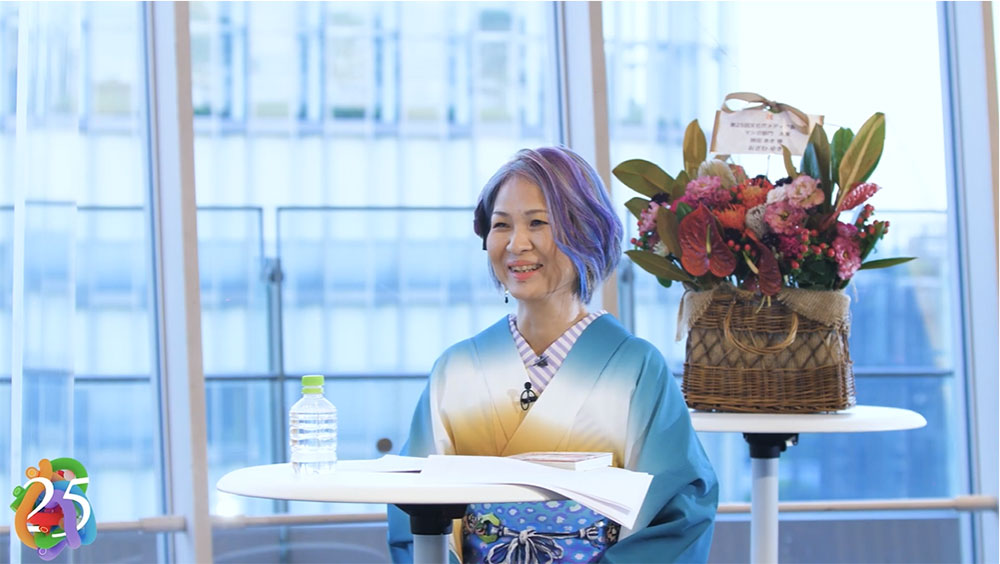
MATSUNAGA said, “Most of the protagonists in josei manga today are in their 20s or 30s, but the older generations who have grown up with manga are now in their 50s or 60s. I sense that the readership of manga is expanding to include higher age groups. While readers can project their past selves onto a young protagonist, it would also be wonderful to read about protagonists who are a little older than you are, who make you think there is a lot of fun waiting in store for you, and help you look forward to growing old and to envision a positive future, as is the case with OZAWA’s Sanju Mariko (2016 to 2021). I hope to see more and more works of this kind.”
In closing, MOCHIDA concluded, “I believe that shojo manga (girls’ comics) and josei manga have a magical power to make a young girl feel like a special woman or take an independent mature woman back to when she was a young girl if she reads them. I want to continue to create such works regardless of the protagonists’ ages. Although the images of the female characters readers want may change with the times, I hope I can keep presenting realistic and attractive characters for any day and age.”
This work is continuing to attract readers thanks to its exhilarating and fast-paced narrative and numerous heart-rending dialogues. According to MOCHIDA, she has already drawn the illustration of the final scene. She is working on the story while keeping in mind the path leading toward that scene. We readers can’t take our eyes off the two principal characters and how they are going to keep moving forward until they reach that final scene.
information
25th Japan Media Arts Festival
Talk Session on the Manga Division Grand Prize-winning Golden Raspberry
Video available at: https://j-mediaarts.jp/en/festival/talk-session/
Speakers:
MOCHIDA Aki (Manga artist/Manga Division Grand Prize Golden Raspberry)
MATSUNAGA Tomoko (Editor/ShuCream Inc.)
OZAWA Yuki (Manga artist/Manga Division jury)
TOYODA Yumetaro (Manga editor/Manga Division selection member)
Organizer: 25th Japan Media Arts Festival Executive Committee
https://j-mediaarts.jp/en/
*URL links were confirmed on November 9, 2022.